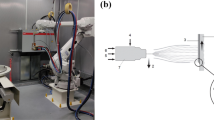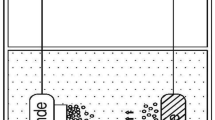Abstract
In this paper, heat transfer characteristics of nickel coating over aluminium and mild steel are examined using jet impingement cooling. A rectangular sheet of dimension 10 cm × 3.5 cm × 0.1 cm taken as the test piece is coated with 4 g nickel acetate tetrahydrate precursor in the chemical vapor deposition (CVD) process for 85 mins. Heat transfer characteristics are studied on three layers of nickel coating (no coating, first coating, and second coating) with an impinging air-jet velocity of 3.5 ms−1 and 6 ms−1. The effect of Reynolds number, the thickness of the coating, jet velocity, distance from the stagnation point, and nozzle diameter on the heat transfer coefficient are investigated. The results show an increase in convective heat transfer characteristics with the Reynolds number, the thickness of the coating, and the nozzle diameter and a substantial decrease with deviation from the stagnation point.

















Similar content being viewed by others
Abbreviations
- DH :
-
Hydraulic diameter [m].
- v:
-
Velocity [ms−1].
- T:
-
Temperature [K].
- h:
-
Convective heat transfer coefficient [Wm−2 K−1].
- D:
-
Characteristic length of the body [m].
- k:
-
Thermal conductivity [Wm−1 K−1].
- Q:
-
Heat transfer rate [W].
- V:
-
Voltage [Volts].
- I:
-
Current [Ampere].
- Dp :
-
Particle size [nm].
- d:
-
Nozzle diameter [mm].
- x:
-
Distance from the point of impingement [cm].
- K:
-
Constant related to crystal shape.
- CVD:
-
Chemical vapor deposition
- Ni(hfa)2 :
-
Ni(hexafluoroacetylacetonate)2
- Ni(CO)4 :
-
Nickel Tetracarbonyl
- Ni[(acac)2en]:
-
Nickel bis(acetylacetone) ethylenediamine
- Cr(acac)3 :
-
Chromium (III) acetylacetonate
- XRD:
-
X-Ray diffraction
- Nu:
-
Nusselt number.
- Re:
-
Reynolds Number.
- μ:
-
Dynamic Viscosity [kgm−1 s−1].
- ρ:
-
Fluid density [kgm−3].
- λ:
-
Wavelength of x-ray [Å].
- β:
-
Half peak width of the diffraction peak [radians].
- θ:
-
Angle between diffracted wave and the lattice plane [degrees].
- a:
-
Air.
- w:
-
Wall.
- x:
-
Distance from the wall.
- l:
-
Local.
- s:
-
Stagnation.
References
Fotovvati B, Namdari N, Dehghanghadikolaei A (2019) On coating techniques for surface protection: a review. J Manuf Mater Process 3:28. https://doi.org/10.3390/jmmp3010028
Gu Y, Xia K, Wu D, Mou J, Zheng S (2020) Technical characteristics and wear-resistant mechanism of nano coatings: a review. Coatings 10:233. https://doi.org/10.3390/coatings10030233
Jones AC, Hitchman ML (2009) Overview of chemical vapour deposition. R Soc Chem 1:1–36. https://doi.org/10.1039/9781847558794-00001
Montazer M, Harifi T (2018). Nanofinishing of textile materials. Woodhead Publishing
Yap YK, Zhang D (2014) Physical vapor deposition. In: Bhushan B (ed) Encyclopedia of nanotechnology. Springer Netherlands, Dordrecht, pp 1–8
Habig K-H (1986) Chemical vapor deposition and physical vapor deposition coatings: properties, tribological behavior, and applications. J Vac Sci Technol A Vacuum, Surfaces, Film 4:2832–2843. https://doi.org/10.1116/1.573687
Quinto DT, Santhanam AT, Jindal PC (1988) Mechanical properties, structure and performance of chemically vapor-deposited and physically vapor-deposited coated carbide tools. Mater Sci Eng A 105–106:443–452. https://doi.org/10.1016/0025-5416(88)90729-X
Spear KE (1982) Principles and applications of chemical vapor deposition (CVD). Pure Appl Chem 54:1297–1311. https://doi.org/10.1351/pac198254071297
Sherman A (1987). Chemical vapor deposition for microelectronics: principles, Technology, and Applications 215
Amazawa T, Nakamura H (1986). Selective chemical vapor deposition of aluminum. Conf Solid State Devices Mater 755–756
Sivaram S (1995). Reactor Design for Thermal CVD. In: Chemical Vapor Deposition. Springer, pp. 94–118
Xu Y, Yan X-T (2010) Chemical vapour deposition systems design. In: Chemical vapour deposition: an integrated engineering Design for Advanced Materials. Springer London, London, pp. 73–128
Li N (2011). Chemical vapor deposition of thin film materials for electronic and magnetic applications. University of Alabama Libraries
Lim KH, Lee J, Huh JE, Park J, Lee JH, Lee SE, Kim YS (2017) A systematic study on effects of precursors and solvents for optimization of solution-processed oxide semiconductor thin-film transistors. J Mater Chem C 5:7768–7776. https://doi.org/10.1039/c7tc01779k
Nalwa HS (2001). Handbook of thin films, Five-Volume Set. Elsevier Science
Nickel Institute (2018). Plating: the role of nickel | Nickel Institute. https://www.nickelinstitute.org/about-nickel/plating/. Accessed 3 Mar 2020
Bansa PB (2001). Property characterization of CVD nickel. National Library of Canada= Bibliothèque nationale du Canada
Billah MM, Chen Q (2017) Thermal conductivity of Ni-coated MWCNT reinforced 70Sn-30Bi alloy. Compos Part B Eng 129:162–168. https://doi.org/10.1016/j.compositesb.2017.07.071
De Jesus JC, González I, Quevedo A, Puerta T (2005) Thermal decomposition of nickel acetate tetrahydrate: an integrated study by TGA, QMS and XPS techniques. J Mol Catal A Chem 228:283–291. https://doi.org/10.1016/j.molcata.2004.09.065
Marceau E, Che M, Čejka J, Zukal A (2010) Nickel(II) nitrate vs. acetate: influence of the precursor on the structure and reducibility of Ni/MCM-41 and Ni/Al-MCM-41 catalysts. ChemCatChem 2:413–422. https://doi.org/10.1002/cctc.200900289
Cho HH, Kim KM, Song J (2011) Applications of impingement jet cooling systems. In: Cooling systems: energy. Nova Science Publishers, Inc., Engineering and Applications, pp 37–67
Liu X, Lienhard JH, Lombara JS (1991) Convective heat transfer by impingement of circular liquid jets. In: Journal of Heat Transfer. pp. 571–582
Gulati P, Katti V, Prabhu SV (2009) Influence of the shape of the nozzle on local heat transfer distribution between smooth flat surface and impinging air jet. Int J Therm Sci 48:602–617. https://doi.org/10.1016/j.ijthermalsci.2008.05.002
Colucci DW, Viskanta R (1996) Effect of nozzle geometry on local convective heat transfer to a confined impinging air jet. Exp Thermal Fluid Sci 13:71–80. https://doi.org/10.1016/0894-1777(96)00015-5
Li G, Zheng Y, Hu G, Zhang Z (2014) Convective heat transfer enhancement of a rectangular flat plate by an impinging jet in cross flow. Chin J Chem Eng 22:489–495. https://doi.org/10.1016/S1004-9541(14)60060-4
Marzec K, Kucaba-Pietal A (2014). Heat transfer characteristic of an impingement cooling system with different nozzle geometry In: Journal of Physics: Conference Series p 12038
Brissonneau L, Vahlas C (2000). Precursors and operating conditions for the metal-organic chemical vapor deposition of nickel films. In: Annales de Chimie: science des Materiaux. Pp 81–90
Premkumar PA, Dasgupta A, Kuppusami P, Parameswaran P, Mallika C, Nagaraja KS, Raghunathan VS (2006) Synthesis and characterization of Ni and Ni/CrN nanocomposite coatings by plasma assisted metal-organic CVD. Chem Vap Depos 12:39–45. https://doi.org/10.1002/cvde.200506415
Anwarullah M, Rao VV, Sharma KV (2011) Effect of nozzle spacing on heat transfer and fluid flow characteristics of an impinging circular jet in cooling of electronic components. Int J Therm Environ Eng 4:7–12. https://doi.org/10.5383/ijtee.04.01.002
Su LM, Chang SW, Yeh CI, Hsu YC (2003) Heat transfer of impinging air and liquid nitrogen mist jet onto superheated flat surface. Int J Heat Mass Transf 46:4845–4862. https://doi.org/10.1016/S0017-9310(03)00319-3
Zukowski M (2013) Heat transfer performance of a confined single slot jet of air impinging on a flat surface. Int J Heat Mass Transf 57:484–490. https://doi.org/10.1016/j.ijheatmasstransfer.2012.10.069
Awbi HB (1998) Calculation of convective heat transfer coefficients of room surfaces for natural convection. Energy Build 28:219–227. https://doi.org/10.1016/s0378-7788(98)00022-x
Upadhyay RK, Kumaraswamidhas LA (2018). Bearing failure issues and corrective measures through surface engineering. In: Handbook of Materials Failure Analysis. Elsevier, pp. 209–233
Rajeshkumar S, Bharath LV, Geetha R (2019) Broad spectrum antibacterial silver nanoparticle green synthesis: characterization, and mechanism of action. In: Green synthesis. Elsevier, Characterization and Applications of Nanoparticles, pp 429–444
Kobayashi H, Kabeya K, Takashima Y, Takahashi H, Takeda G (2018) Effect of nozzle geometry and distance on cooling performance of impinging jets. ISIJ Int 58:1500–1509. https://doi.org/10.2355/isijinternational.ISIJINT-2018-133
Yasaswy NS, Saroj S, Hindasageri V, Prabhu SV (2014) Local heat transfer distribution of an impinging air jet through a crossflow. Int J Therm Sci 79:250–259. https://doi.org/10.1016/j.ijthermalsci.2014.01.006
Author information
Authors and Affiliations
Corresponding author
Ethics declarations
Conflict of interest
On behalf of all authors, the corresponding author states that there is no conflict of interest.
Additional information
Publisher’s note
Springer Nature remains neutral with regard to jurisdictional claims in published maps and institutional affiliations.
Rights and permissions
About this article
Cite this article
Bhasuru, V.K., Varshney, S., Agarwal, Y. et al. Heat transfer studies of surface synthesized by chemical vapor deposition. Heat Mass Transfer 56, 3229–3241 (2020). https://doi.org/10.1007/s00231-020-02931-9
Received:
Accepted:
Published:
Issue Date:
DOI: https://doi.org/10.1007/s00231-020-02931-9




